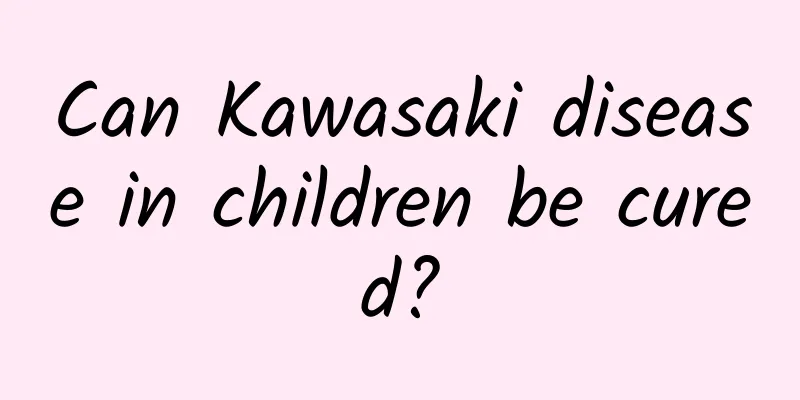Can Kawasaki disease in children be cured?

|
Kawasaki disease in children can be cured, but it needs to be diagnosed and treated as soon as possible in the early stages of the disease to reduce the risk of complications and increase the recovery rate. Treatment usually includes medication (such as intravenous immunoglobulin and aspirin), combined with symptomatic supportive treatment when necessary, and the family needs to adjust the care method in daily life to ensure the health of the child. 1) Causes and pathology of Kawasaki disease The exact cause of Kawasaki disease has not yet been determined, but it is believed that it may be related to genetic factors, infection, and immune system abnormalities. In terms of genetics, the incidence of Kawasaki disease is higher in some families; environmental factors such as viral or bacterial infections and pollution are also considered potential causes; physiologically, an overreaction of the immune system may be the key to the onset of the disease. Typical manifestations of Kawasaki disease include fever, rash, conjunctival congestion, lip flushing, limb peeling, etc. The most serious complication is coronary artery disease. Parents should seek medical attention immediately if they find that their children have a persistent high fever accompanied by the above symptoms. 2) Main treatments for Kawasaki disease The core goal of treating Kawasaki disease is to reduce inflammation and prevent coronary artery disease. The main treatments include: (1) Intravenous immunoglobulin (IVIG): IVIG is the first-line treatment for Kawasaki disease. It is usually used within 10 days of onset and can significantly reduce the inflammatory response and reduce the risk of coronary artery disease. (2) Aspirin: Aspirin can be used for anti-inflammatory purposes in the acute phase and to reduce the risk of thrombosis, but the dosage and course of treatment must be controlled according to the doctor's instructions. (3) Symptomatic supportive treatment: If the child has severe symptoms (such as myocarditis), anticoagulants, oxygen therapy or other cardiac supportive treatments may be needed. Daily care is also important. The child should be given enough rest but avoid strenuous activities, especially when the heart disease has not fully recovered. 3) Precautions in nursing and daily life After the child is treated, parents need to take the child for regular checkups, such as cardiac ultrasound and blood tests, to ensure that the condition is monitored properly. In terms of diet, it is recommended to provide light, high-vitamin, high-protein food to help enhance immunity; avoid giving children irritating or high-salt and high-fat foods. Parents should also pay attention to the child's mental state and provide a good recovery environment. As long as Kawasaki disease is detected and treated early, and the relevant management plan is completed according to the course of treatment, most children with it can fully recover. However, parents need to be alert to the serious consequences such as coronary artery disease that may result from delayed treatment. Therefore, if suspected symptoms are found, take the child to the hospital immediately for professional help, and do not ignore the examination and treatment of early symptoms. |
<<: What are the symptoms of patent ductus arteriosus in newborns?
>>: Why do newborns have jaundice?
Recommend
What are the symptoms of diarrhea in children?
There are many symptoms of diarrhea in children, ...
Will tonsillitis in children cause fever? What are the dietary methods for treating tonsillitis?
What is the diet for children with tonsillitis? T...
What to do if children have allergic rhinitis and cough
If children have allergic rhinitis or cough, they...
Treatment principles for acute laryngitis in children
The principle of treating acute laryngitis in chi...
Is jaundice contagious?
Patients with chronic hepatitis will experience a...
What are the nursing measures for children with pneumonia? How to tell if a child has pneumonia
With the arrival of autumn, the temperature diffe...
What are the treatment principles for patent ductus arteriosus in newborns?
The treatment principles for patent ductus arteri...
What medicine is good for children with cold, fever and runny nose?
What medicine is good for children with cold, fev...
How to cure pneumonia in children
In life, everyone may not know much about the tre...
What are the effects of soaking orange peel in water? What are the effects of soaking orange peel in water?
In daily life, we always see people using orange ...
What medicine is good for children's cough
It is better for children to take medicines such ...
What are the examinations for pneumonia in children?
Pneumonia is a common disease, and children are t...
Is hand, foot and mouth disease serious in adults? Is it contagious?
HFMD in adults is generally not serious, but it i...
What are the treatment principles for breast milk diarrhea?
What are the treatment principles for breast milk...
Methods of early prevention of polio
Polio is an acute infectious disease caused by th...









